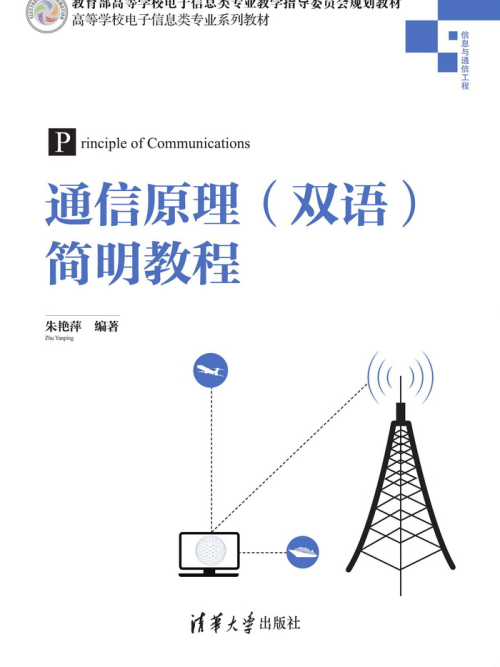《通信原理(雙語)簡明教程》是2019年6月清華大學出版社出版的圖書,作者是朱艷萍。
基本介紹
- 中文名:通信原理(雙語)簡明教程
- 作者:朱艷萍
- 出版社:清華大學出版社
- 出版時間:2019年6月
- 定價:49 元
- ISBN:9787302520573

《通信原理(雙語)簡明教程》是2019年6月清華大學出版社出版的圖書,作者是朱艷萍。
《通信原理(雙語)簡明教程》是2019年6月清華大學出版社出版的圖書,作者是朱艷萍。內容簡介本書重點介紹通信系統中各種通信信號的產生、傳輸和調製解調的基本理論和方法,使學生熟悉並掌握通信系統的基本理論和分析方法,為後續課...
《通信原理簡明教程》是2012年機械工業出版社出版的圖書,作者是鄔正義,本書講述以現代通信系統為背景,以點對點的電信號通信為主線,全面介紹通信的基本工作原理和分析方法。內容簡介 本書以現代通信系統為背景,以點對點的電信號通信為主線...
《通信原理簡明教程》是2000年2月清華大學出版社出版的圖書,作者是南利平。內容簡介 本書全面系統地介紹了信號分析、線性系統分析的基本理論和方法,並對數位訊號處理的基礎知識作了必要的討論,相對於有關的這類書而言是一本少而精的...
《通信原理簡明教程》是2021年清華大學出版社出版的圖書,作者是楊瑋。內容簡介 《通信原理簡明教程(第4版)學習輔導與習題解答/面向新工科的電工電子信息基礎課程系列教材》是清華大學出版社出版的《通信原理簡明教程》(第4版)的配套...
《通信原理簡明教程》是2018年華中科技大學出版社出版的圖書。內容簡介 “通信原理”是通信領域中重要的專業基礎課之一,學習該課程是進一步學習通信領域的各種專業知識的關鍵基礎。目前,該課程幾乎成為所有通信、電子信息等專業的必修課程。...
《通信原理簡明教程(第4版)》以現代通信系統為背景,全面地介紹通信系統的一般模型和通信技術的基本原理,包括對5G中心技術的介紹。《通信原理簡明教程(第4版)》共9章,內容包括緒論、基礎知識、模擬通信系統、模擬信號的數位化、數字...
《通信原理簡明教程(第2版)》是機械工業出版社2016年8月出版的書籍,本書的基本內容與第1版一致,包括通信的基本概念、模擬調製系統、信源編碼、數位訊號的基帶傳輸系統、數位訊號的調製傳輸系統、差錯控制與信道編碼、同步原理等。內容...
《通信原理簡明教程(第3版)學習輔導與習題解答》是2014年清華大學出版社出版的圖書,作者是李學華、王亞飛、李振松、南利平。內容簡介 全書分為兩部分: 第一部分為學習輔導和習題解答,包括《通信原理簡明教程(第3版)》教材中第1~9...
《通信原理與技術簡明教程》是2013年7月22日清華大學出版社出版的圖書,作者是張衛鋼、張維峰。內容簡介 《通信原理與技術簡明教程》本書全面、系統地介紹了現代通信原理和相關的通信技術。全書分為兩篇,共17章,內容包括:通信與通信...
《通信原理教程》是2016年中國工信出版集團、電子工業出版社出版的圖書,作者是達新宇。內容簡介 全書介紹了通信系統的基本概念、工作原理、主要技術及分析方法。具體內容包括:通信中信號分析、模擬調製系統、數字基帶傳輸系統、數字頻帶傳輸...
《通信原理教程》是2011年人民郵電出版社出版的圖書,作者是李衛東、李殷、游思晴。本書闡述了通信系統的基本問題,主要包括確定信號與隨機信號分析、信道特性、調製技術、信道編碼,擴頻通信和通信網等內容。編輯推薦 《21世紀高等院校信息...
《通信原理教程(第4版)》是2019年6月電子工業出版社出版的圖書,作者是樊昌信。內容簡介 本書在簡要介紹模擬通信原理的基礎上,以數字通信原理為重點,講述通信系統的組成、性能指標、工作原理、性能分析和設計方法。對於近年來新出現的...
《簡明通信原理》是2011年5月出版的圖書,作者是曹麗娜。本書全面系統地介紹通信系統的基本概念、基本原理和分析方法。內容提要 《簡明通信原理》全書共分9章,內容包括緒論、信號和頻譜、信道和信道容量、模擬調製和頻分復用、模擬信號的...
現代通信原理與技術簡明教程 《現代通信原理與技術簡明教程》是2014年北京大學出版社出版的圖書。
《現代通信原理與技術簡明教程》是2006年1月1日北京大學出版社出版的圖書,作者是張平川。內容簡介 本書主要作為通信工程或電子信息專業高職學生的教材,也可作為相關領域的科技人員參考讀物,或培訓教材。本書分三大部分,第一部分全面系統...
通信原理(雙語)通信原理(雙語)課程是由宋鐵成為課程負責人,東南大學為主要建設單位的國家級一流本科課程。 教師團隊 課程負責人:宋鐵成 所獲榮譽 2020年11月24日,該課程被中華人民共和國教育部認定為“首批國家級一流本科課程”。
《移動通信原理與技術簡明教程》是2006-5-1北京大學出版社出版的圖書,作者是吳保奎 。內容簡介 本書是專為高職高專電子信息專業編寫的移動通信原理與技術簡明教程,較為全面、系統地闡述了現代移動通信的基本原理、基本技術和當今廣泛使用...
《通信原理實用教程——使用MATLAB仿真與分析》是清華大學出版社於2022年出版的書籍,作者是向軍 內容簡介 本書全面介紹現代通信系統的基本組成模型和信息傳輸中的各種調製解調技術, 全書共分8章, 內容 包括通信和信息傳輸的基本概 念, ...
朱艷萍,女,南京信息工程大學電子與信息工程學院老師。主要研究方向為:陣列信號處理、MIMO雷達/通信頻譜共享、智慧型信號處理等。編寫教材:1《通信原理(雙語)簡明教程》清華大學出版社,2018。2《遙控遙測技術》講義,2010。人物經歷 教育...
